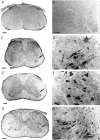Neuron-specific expression of mutant superoxide dismutase 1 in transgenic mice does not lead to motor impairment
- PMID: 11331366
- PMCID: PMC6762496
- DOI: 10.1523/JNEUROSCI.21-10-03369.2001
Neuron-specific expression of mutant superoxide dismutase 1 in transgenic mice does not lead to motor impairment
Abstract
Mutations were identified in the Cu/Zn superoxide dismutase gene (SOD1) in approximately 15% of patients with familial amyotrophic lateral sclerosis. Transgenic animals expressing mutant SOD1 in all tissues develop an ALS-like phenotype. To determine whether neuron-specific expression of mutant SOD1 is sufficient to produce such a phenotype, we generated transgenic animals carrying the G37R mutation that is associated with the familial form of ALS (FALS), which is driven by the neurofilament light chain promoter. The transgenic animals express high levels of the human SOD1 protein in neuronal tissues, especially in the large motor neurons of the spinal cord, but they show no apparent motor deficit at up to 1.5 years of age. Our animal model suggests that neuron-specific expression of ALS-associated mutant human SOD1 may not be sufficient for the development of the disease in mice.
Figures





Similar articles
-
Human Cu/Zn superoxide dismutase (SOD1) overexpression in mice causes mitochondrial vacuolization, axonal degeneration, and premature motoneuron death and accelerates motoneuron disease in mice expressing a familial amyotrophic lateral sclerosis mutant SOD1.Neurobiol Dis. 2000 Dec;7(6 Pt B):623-43. doi: 10.1006/nbdi.2000.0299. Neurobiol Dis. 2000. PMID: 11114261
-
Selective loss of neurofilament expression in Cu/Zn superoxide dismutase (SOD1) linked amyotrophic lateral sclerosis.J Neurochem. 2002 Sep;82(5):1118-28. doi: 10.1046/j.1471-4159.2002.01045.x. J Neurochem. 2002. PMID: 12358759
-
Rats expressing human cytosolic copper-zinc superoxide dismutase transgenes with amyotrophic lateral sclerosis: associated mutations develop motor neuron disease.J Neurosci. 2001 Dec 1;21(23):9246-54. doi: 10.1523/JNEUROSCI.21-23-09246.2001. J Neurosci. 2001. PMID: 11717358 Free PMC article.
-
Oxidative stress, mutant SOD1, and neurofilament pathology in transgenic mouse models of human motor neuron disease.Lab Invest. 1997 Apr;76(4):441-56. Lab Invest. 1997. PMID: 9111507 Review.
-
Transgenic mouse model for familial amyotrophic lateral sclerosis with superoxide dismutase-1 mutation.Neuropathology. 2001 Mar;21(1):82-92. doi: 10.1046/j.1440-1789.2001.00361.x. Neuropathology. 2001. PMID: 11304046 Review.
Cited by
-
Neural and glial progenitor transplantation as a neuroprotective strategy for Amyotrophic Lateral Sclerosis (ALS).Brain Res. 2015 Dec 2;1628(Pt B):343-350. doi: 10.1016/j.brainres.2015.06.035. Epub 2015 Jul 14. Brain Res. 2015. PMID: 26187754 Free PMC article. Review.
-
Nitric oxide-mediated oxidative damage and the progressive demise of motor neurons in ALS.Neurotox Res. 2012 Nov;22(4):251-64. doi: 10.1007/s12640-012-9322-y. Epub 2012 Apr 10. Neurotox Res. 2012. PMID: 22488161 Free PMC article. Review.
-
Ablation of interleukin-19 improves motor function in a mouse model of amyotrophic lateral sclerosis.Mol Brain. 2021 Apr 30;14(1):74. doi: 10.1186/s13041-021-00785-8. Mol Brain. 2021. PMID: 33931083 Free PMC article.
-
Dysregulation of stathmin, a microtubule-destabilizing protein, and up-regulation of Hsp25, Hsp27, and the antioxidant peroxiredoxin 6 in a mouse model of familial amyotrophic lateral sclerosis.Am J Pathol. 2004 Nov;165(5):1701-18. doi: 10.1016/S0002-9440(10)63426-8. Am J Pathol. 2004. PMID: 15509539 Free PMC article.
-
Mutations in Caenorhabditis elegans cytoplasmic dynein components reveal specificity of neuronal retrograde cargo.J Neurosci. 2004 Apr 21;24(16):3907-16. doi: 10.1523/JNEUROSCI.5039-03.2004. J Neurosci. 2004. PMID: 15102906 Free PMC article.
References
-
- Bruijn LI, Becher MW, Lee MK, Anderson KL, Jenkins NA, Copeland NG, Sisodia SS, Rothstein JD, Borchelt DR, Price DL, Cleveland DW. ALS-linked SOD1 mutant G85R mediates damage to astrocytes and promotes rapidly progressive disease with SOD1-containing inclusions. Neuron. 1997;18:327–338. - PubMed
-
- Ceballos-Picot I, Nicole A, Briand P, Grimber G, Delacourte A, Defossez A, Javoy-Agid F, Lafon M, Blouin JL, Sinet PM. Neuronal-specific expression of human copper/zinc superoxide dismutase gene in transgenic mice: animal model of gene dosage effects in Down's syndrome. Brain Res. 1991;552:198–214. - PubMed
-
- Charron G, Guy LG, Bazinet M, Julien JP. Multiple neuron-specific enhancers in the gene coding for the human neurofilament light chain. J Biol Chem. 1995;270:30604–30610. - PubMed
Publication types
MeSH terms
Substances
LinkOut - more resources
Full Text Sources
Other Literature Sources
Medical
Molecular Biology Databases
Miscellaneous
